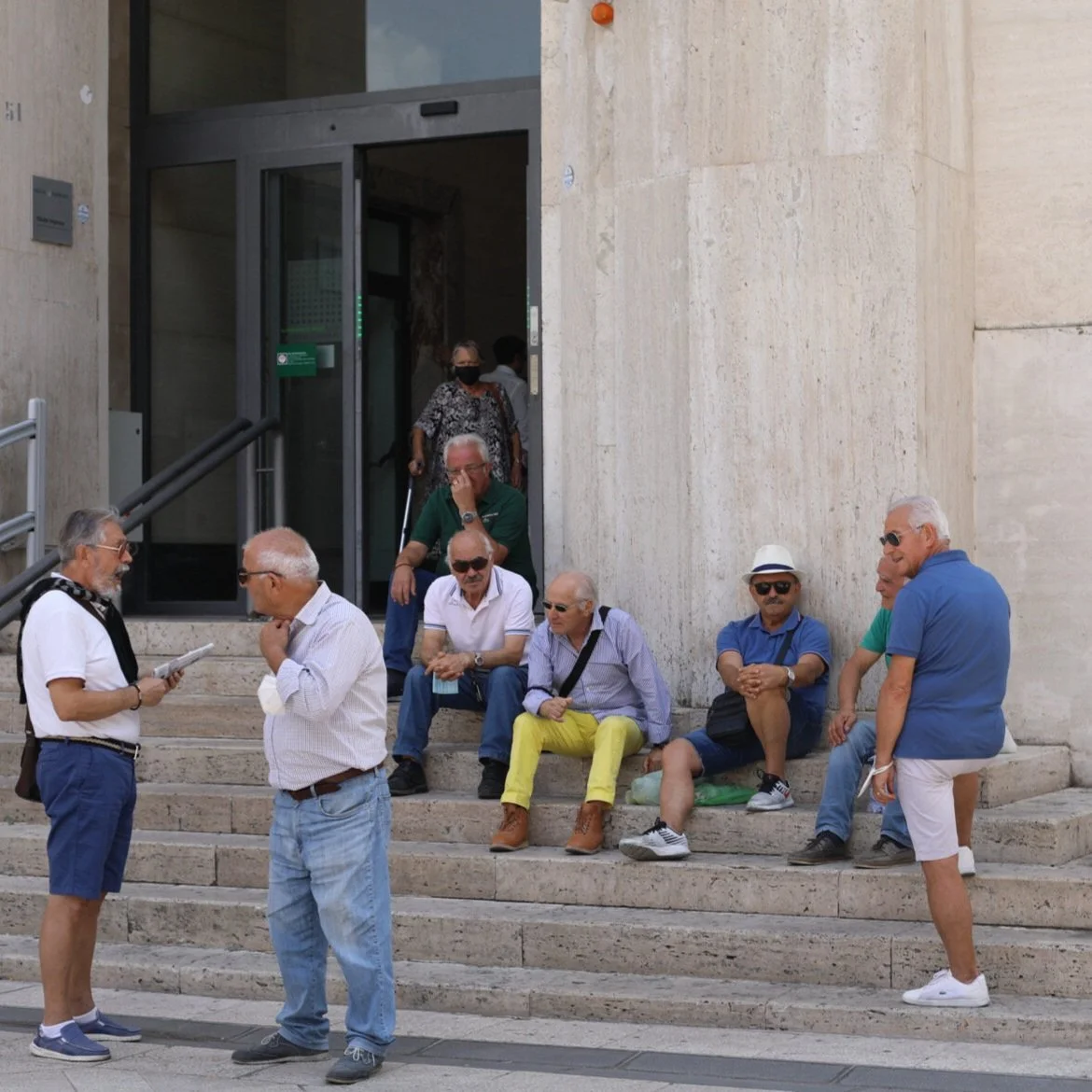Into the caves
Our full day in Matera started with a lovely breakfast on our terrace area in the alley between the cave houses.
Colin enjoying breakfast in the terrace area
Next we explored Matera a little more on our own before our tour with Angela via Airbnb Experiences. We saw the mail being delivered with a tiny cart, the locals lined up for bread, and the men having their morning catch up.
Our tour with Angela was really good. She was very informative. Her grandfather was from Matera and she grew up in the countryside nearby so she had a real connection to the city. First we learned about a giant cistern underneath one of the main squares it was 15m high and could have fit a small church. It was built in the 1800s to supply water to the newer houses on top of the plateau that did not have their own cisterns as the cave houses originally did.
It was sad to learn of the poor living conditions of the cave houses only a generation ago. The infant mortality rate was close to 70% which forced the residents, numbering around 60,000 to be moved forcibly from their cave houses to nearby modern housing in the 1950-60s. The poor conditions were due primarily to lack of running water and sanitation in the houses. The Aquedotto Pugliese had just brought the water into town in 1920, but each household still had to go fetch their own from fountains. Cooking fires and warming braziers in the caves and animals in the living areas combined with poor ventilation also contributed to the poor conditions. All the cave houses were then abandoned for around 20-30 years. Refurbishment of some houses began in the 1980s and in 1993 the Sassi Caveosa and Sassi Barisano of Matera were declared a UNESCO world heritage site. This led to further renovations and restorations along with the conversion of many homes into hotels and bed and breakfasts.
Only about 1000 permanent residents live in the Sassi now, with most other caves being restaurants, shops, and hotels. Our guide pointed out that for older residents it would be difficult to live in the cave houses, especially in the winter when it is cold and the local stone from which the streets are made becomes as slick as ice.
She filled us in on the progression from pagan shrines in the 6-8th centuries to rock churches in the same caves once Catholic monks arrived in the area in the 10-11th century or so. At the end of the tour we saw a reconstruction of one of the cave houses from the 18th century. It was startling to see the donkey’s head poking out from behind the headboard of the bed. Many of the residents apparently lived in their caves in small communities called vicini. They shared a large central cistern and each also had their own cisterns. The women wouldn’t leave these small areas alone.
We also learned about the famous Materan bread, which weigh about 5 kilos. It is soft on the inside and crunchy on the crust. Loaves were made weekly by the women who took them to the communal ovens. Each families loaf was stamped with their bread stamp so they knew which one belonged to them when the loaves came out of the oven. There are several local dishes that use the bread, including a bread salad called, cialledda, similar to panzanella.
Below are some photos from the tour.
Lunch was casual. Sara tried the cialledda bread salad and Colin had a black pork sandwich. Both were delicious.
After lunch we drove out into the hills near Matera to see some of the rock churches from the 11-15th centuries. We parked in the remote lot and walked about a mile in to see the churches, later we noticed many others just drove around the barrier. You live, you learn.One church in particular had lovely frescoes, the Chiesa Rupestre di Madonna delle Tre Porte.
Later in the afternoon after siesta we saw the oldest rock church in town, Chiesa di Santa Lucia alle Malve. The frescoes had just been restored and were stunning in their bright colors despite being around 900 years old. The image of one of the archangels really stood out.
Dinner was a classy affair at L’Abbondanza Lucana. Lucania is the ancient name for this area. Colin had Orrechiete with Asparagus sauce with sausage and pepperoni cruschi. Sara had a fresh pasta with funghi porcini and cacciocavallo (a local cheese) topped with pistachios. The pistachios atop pasta seem to be very common in Lucania. We also tried an amazing Materan Primitivo wine. It was excellent!
Bells ringing for vespers in Matera


















































